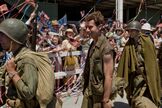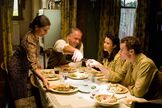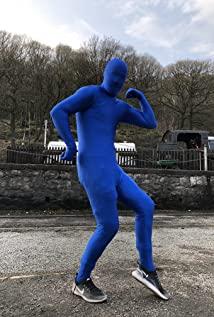1. Guadalcanal landing day is August 7, 1942. The U.S. landing force reached 10,000. The Japanese army did not resist because there were only 2,800 Japanese defenders on the island, and most of them were from South Korea. There were only a few hundred workers in the fighting force, and they were all near the airport. At the same time, the Japanese did not expect that the U.S. military would suddenly launch a landing, so they encountered no resistance during the U.S. landing.
2. The naval battle was the battle of Savo Island on the evening of August 8, 1942. In this battle, the U.S. Army was defeated and 4 heavy cruisers were lost. Another heavy cruiser and 2 destroyers were severely damaged. More than 1,000 U.S. The navy was killed in battle; while no Japanese warship sank, only 58 people were killed. (The situation of the U.S. Navy and the U.S. Marine Corps in the Pacific War is opposite. The U.S. Marine Corps fought smoothly at the beginning of the war, but the greater resistance it encountered as the war began. Shun).
3. That night battle was the Tenaru Estuary battle that broke out in the early morning of August 21, 1942 (in fact, the U.S. military made a mistake. The place was actually the mouth of the Yilu River. The local indigenous people called the Yilu River the Crocodile Creek. Therefore, this battle was called the battle at the mouth of the Yiru River; later the US military also discovered this error, so the US military did not write Tenaru River "Tenaru River" in the film, but used what the indigenous people called "Crocodile Creek." To express).
4. The Japanese army participating in the Tenaru River Estuary battle was the Ichiki Detachment, with a strength of 900. The U.S. forces participating in the battle included defensive forces and counterattack forces, about 2000-3000; because the US army had accidentally learned the direction of the Japanese army's main attack (first one The U.S. scouts ambushed Ichiki’s patrol, seized a map of the Japanese army and learned about the direction of the Japanese army’s possible offensive; followed by a pro-Western native who managed to escape back to the U.S. defense line after being captured by the Japanese army. , Provided relevant information of the Japanese army), so on the only way for the Japanese army, the machine guns and artillery were all calibrated, the fortifications were strengthened, and all artillery observers were on standby at the front line, just waiting for the Japanese army to come.
5. In the movie, battle broke out in the dark. Many friends felt that shooting night battles was not addictive, but there was no way. History is like this. There are also friends who questioned how the Japanese army was going to die like crazy. In fact, the core of the Japanese army's tactics is penetration + night combat. In the early stage of the Southeast Asian battlefield, this trick has been successful, so the US army in Guadalcanal is not considered, it is still the case. It is offensive, and everyone does not know that the U.S. military has already had an advantage in terms of troop strength, firepower, intelligence collection, preparations, and other aspects at this time. Several details of the battle in the film are well grasped. One is that the battle revolves around a sandbank (the Japanese wanted to rush through this sandbank, but they were all swept down by the US military machine guns). This is in line with history, Crocodile Creek. The entrance to the sea is actually a lagoon with a ring-shaped sandbank. If the Japanese army wants to cross the Crocodile Creek to attack the American troops on the opposite bank, they must pass through the sandbank. Therefore, there are heavy casualties here. The death pillow on the sandbank, the Japanese army who committed suicide was on the sandbank); another detail is that the US military reminded each other that the Japanese soldiers attacked from the flanks. Through the centripetal attack on the sandbank, there is another wave of attempts to wading from the coast to swim around to the US military flank to attack (this is why there are a large number of Japanese corpses on the beach in the morning in the film).
6. In the daytime, the corpses in the sea and on the beach are as mentioned above. It is not the dead people on the sunken Japanese warship that some friends said, but the part of the Ichiki Detachment who tried to detour through the beach and attacked. personnel. The Japanese army who committed suicide is also verifiable. At the end of the Tenaru battle in history, US medical personnel tried to treat the wounded Japanese soldiers, but the Japanese soldiers fired grenades and died together with the US soldiers. For this reason, the US military ordered the Japanese soldiers not to be treated. Run over directly by the tank. However, in the film, it seems that the battle ended a little bit sooner. In fact, the battle lasted 16 hours and ended at 17:00 that evening. In this battle, the Japanese army killed 777 people, while the US army killed 34 and injured 75.
7. A few other details: Robert Leckie, the protagonist in the first episode of the film, is a machine gunner from the 1st Marine Corps and 2nd Battalion. This battalion is also the unit that participated in the battle at the Tenaru Estuary; the American soldier who drank Japanese beer was also historically Indeed, after the US army occupied the airport, they accidentally found dozens of boxes of beer left by the Japanese army and enjoyed it. The 7th Marines landed on September 18, 1942, and among them was John, who became famous in World War I. -Basron.
8. Finally, this film is based on three Marines as the prototype. They are Robert Leckie from the 2nd Battalion of Marines 1st Regiment (the protagonist of the first episode), and Eugene Sledge from the 3rd Battalion of the Marines 5th Regiment (first episode) The one who had a heart attack and could not participate in the war), John Basilone of the 1st Battalion of the 7th Marine Corps (saying goodbye to his father in the first episode). Among them, John Basilone was the recipient of the Medal of Honor. He later joined the 5th Marine Division and died in the Battle of Iwo Jima. Both Robert Leckie and Eugene Sledge died in 2001.
9. You can pull the film to 22:22, which is the moment when the American landing craft departs. Pay attention to the big ship at the back left of the screen. This ship is named George F. Elliott, which is a transport ship. Carried the 1st Marine Division 1st Regiment 2nd Battalion (that is, the unit where the protagonist Bob is located). You can take a look at the historical photo of the Elliott I posted below. Do you think the ship in the film is almost exactly the same as the photo? !
10. Someone asked why the U.S. army had landed when the protagonist’s landing craft landed ashore. Because the protagonist was in the 1st Marine Regiment, before it landed, at 9:38 that day, the 5th Marine Regiment had landed; the 1st Marine Regiment landed at 11:00, one and a half hours later than the brothers, and The landing point was just to the right of the landing point of the 5th Marine Corps. It can be seen that this film absolutely respects historical facts in this detail.
11. Regarding the two corpses found by the US military in the jungle, I personally believe that they were not the corpses of US soldiers, but the coast watcher that had previously performed reconnaissance missions on Guadalcanal Island. Coast guard posts are mostly composed of soldiers and armed civilians from Australia, New Zealand, and the British Solomon Islands. These people are equipped with radio stations and go deep behind enemy lines to provide intelligence to the Allied forces. In the Pacific War, these people played a pivotal role. They often sent news to the Allied forces at the same time that the Japanese army deployed troops; but at the same time, they also endured great danger. Once captured by the Japanese army, they would suffer absolutely. It is a more cruel punishment than ordinary Allied soldiers.
12. There are also historical records about the accidental injury to the friendly army. Because the US military lacks combat experience and is not familiar with the environment, although the Japanese army did not take action, many shootings broke out due to wind and grass in the US military positions. Both the 5th Marine Regiment and the 1st Marine Regiment were accidentally injured.
13. The Elliott mentioned in 33:55 of the film is the transport ship that the protagonist took before the landing of the 2nd Battalion, 1st Marine Regiment. Turner was the commander of the US and Chinese navy in the Battle of Guadalcanal at the time. Elliott sank on August 8, 1942, the day after Guadalcanal landing. It sank at 1 o'clock in the afternoon. It was two separate battles against the sea battle on Savo Island that broke out that night. Elliott was sunk by an air attack, and the US military said in the film that "Zero crashed into her midship" refers to a Japanese aircraft (actually a torpedo plane is not a zero aircraft, but the US military at the time may not be so clear) was hit. Later, he fell on the ship and caused a fire. It was this fire that caused Elliott to be forced to abandon and scuttled by the U.S. military. Elliott carries a large amount of supplies for the Landing Battle 1st regiment, so the main character's unit will be frustrated by this.
14. In the film, when the US military packed up the belongings of the Japanese soldiers who died, they said, "They are the Japanese soldiers who occupied Guam." This is not an unintentional statement. The Ichiki Detachment originally planned to participate in the landing operation in the Battle of Midway, but due to the defeat of the Japanese army on Midway, the Ichiki Detachment had to withdraw to Guam and made a short stop there. Therefore, when the U.S. military looked through the items of the Japanese army, they found that these Japanese soldiers had been to Guam, and then believed that they were the Japanese soldiers who occupied Guam. (However, in history, it was the South China Sea Detachment that really occupied Guam, which had nothing to do with the Yimu Detachment).
15. The 7th Marine Regiment appeared at the end of the film. The protagonist’s unit greeted an officer named Chesty Puller. This Puller was the commander of the 1st Battalion of the 7th Marine Regiment (Baslong was also in this battalion), a Legendary Marine Corps officer. He has won the Naval Cross 5 times in his life, which is unique in the US Marine Corps. In the Battle of Guadalcanal, he will lead the 7th Marine Corps to participate in the bloody battle of the Matanikau River (September 23-27, Lu 7th Regiment) Day 5 after landing) Fight with Henderson Airport. In the battle of the Matanikau River, the US army was in an ambush by the Japanese army, and because of its wit and decisiveness, it saved the US army of three companies; in the battle at Henderson Field, Puller defeated the Japanese army's crazy attack. Throughout the Battle of Guadalcanal, as the battalion commander, he was injured three times, two by a sniper, and one by shrapnel.
In the second episode, I personally estimate that in addition to the well-known battle at Henderson Airport, there may be a battle on the Matanikau River, let us wait and see.
Figure 1 is a screenshot of the movie, and Figure 2 is a historical picture of the George F. Elliott. It feels that the superstructure is basically the same; the pattern of the ship's side is almost the same except for the slight difference in the bow. "P13" in Figure 1 is written larger, which may be to make it easier for the audience to recognize (the ship’s number is AP-13, but it is P13 when it is compiled on board); in Figure 2, P13 is the whiteness of the bow. Basically can't see clearly.
In the second episode
1, the small-scale battle at the beginning is supposed to be the second battle on the Matanikau between October 7th and 9th, 1942. The Matanico River is located to the west of the U.S. ring position (the Crocodile Creek in the first episode is located to the east of the position, and the blood ridge as we know it is located to the south of the position). On the opposite bank of the river, there were many Japanese forces gathering, which caused the U.S. position Quite a threat. Therefore, the U.S. Army organized the first battle on the Matanika River on September 23, 1942, but the battle was ambushed by the Japanese and failed. The attack on October 7, 1942 was a success. It severely damaged the 4th Wing of the 2nd Division of the Japanese Army. The U.S. Army wiped out about 700 Japanese at the cost of about 200 casualties.
2. The U.S. Army unit that landed was the 164th Infantry Regiment. They landed on October 13, 1942. At the same time, there were enough supplies and a large number of other materials for the 1st Marine Division to be transported to the island for 60 days. At this time, the total strength of the US military on Guadalcanal reached more than 23,000, and the Japanese army at this time was also close to 20,000, but the equipment and supplies could not be compared with the US military. The 164th Infantry Regiment played an important role in the subsequent battle for the airport.
3. It is true that the Marines in the film "stealing" army supplies. At that time, the 164th regiment had just landed, and several Japanese bombers came to bomb the airport as usual; the army soldiers hurriedly fled to find cover, and they were accustomed to land warfare. The team members expected that the Tingri machine would not attack the beachhead supplies, so they came to the army brother's supply. At this time, the Army's 164th Regiment was equipped with M1 rifles, but many Marines thought that the Springfield rifles were more accurate and dismissed the M1. However, there were still a small number of Marines who stole the Army's M1 as early adopters.
The landing of the 4,164 Infantry Regiment gave hope to the Lu 1 Division of Guadalcanal Island, but on the night of October 13, 1942, these infantrymen and marines tasted the most fierce Japanese warship against Guadalcanal Airport. Artillery attack (the night bombardment in the movie): The two Japanese battleships fired a total of 918 360 mm artillery shells, and the bombardment lasted for a full 80 minutes. The shelling caused great damage to Guadalcanal Airport. A total of 48 aircraft were destroyed or injured, 41 people were killed and hundreds of others were injured, and a large amount of fuel was destroyed.
5. During the pre-war mobilization, Lieutenant Colonel Puller of the 1st Battalion of the 7th Marine Corps (that is, the shriveled old man) said that the Japanese tried to attack from the vicinity of the Matanikau River. This was correct. At that time, the U.S. Army judged that the Japanese army’s offensive direction was the Matanikau River west of the position, because the Japanese army deployed heavy artillery and tank troops there; and the Japanese army had launched several small-scale attacks here, and the U.S. army firmly believed that this place would be the Japanese army. The main direction of attack. (In fact, the main direction of the Japanese army's attack was the Xueling area south of the position, that is, the defense zone of the 1st Battalion.)
6. The Hanneken unit mentioned by Puller during the mobilization was actually the 2nd Battalion of the 7th Marine Corps. Hanneken was the battalion commander. This unit was being transferred from the south of the position to the front-line reinforcements of the 5th Marine Regiment on the Matanikau River in the west of the position. To prevent the Japanese from attacking from there. The sector 3 mentioned in the film is not the "three rows" as mentioned in the subtitles, but refers to the third defense zone, that is, the defense zone around Xueling. At that time, the U.S. Army divided Guadalcanal into five defense zones, and the blood ridge defended by the 1st Battalion of the 7th Marine Corps was located in the third defense zone.
7. The Briggs mentioned in the film refers to Ralph Briggs, a platoon leader of the 1st Battalion of the 7th Marines. He led 46 men to establish an outpost in front of the main US military positions. On the night that the Japanese army attacked the airport, the outpost of Briggs was the first to spot the movement of the Japanese army, but they did not move. The Japanese army did not find them in the dark. Briggs then contacted Puller (described in the film), and Puller required all artillery to be silent to ensure that Briggs and others would withdraw safely. In the end, 42 of Briggs and other 46 people withdrew to the U.S. defense line (one of them did not escape until 2 weeks later), and 4 people were found by the Japanese and killed on the way.
8. Here I mainly mention the situation of the Japanese army's attack on Guadalcanal Airport (Henderson Airport), and also talk about why the Japanese army would adopt the "suicide" tactics in the film. After being defeated in the Tenaru River Estuary battle and the Battle of the Blood Ridge, the Japanese army successively transported the main force of the Second Division to Guadalcanal in early October 1942, and decided to launch a Jedi counterattack against the American forces in Guadalcanal and retake the airport. At that time, the Japanese army's plan was to divide its forces into two parts. One part was to contain the forces deployed in the Matanikau River to the west of the US positions, and part of the main offensive troops went to the Blood Ridge area to the south of the US positions. In order to achieve this plan, about 7,000 Japanese troops from the south front of the three regiments began to travel long distances from the vicinity of the Matanikao River to the south of the US positions. Many Japanese troops were required to carry one artillery shell each. The trek began on October 16th and passed through countless rivers, valleys and jungles on the way. When it finally reached its destination on October 23rd, the Japanese army was exhausted long ago, and most of the artillery and shells were thrown along the way. , So that when the attack was launched, the Japanese army on the southern line had only one 75mm mountain cannon and 20 rounds. In addition, the Japanese army generally only carried about 7 days of rations when they landed (because the Japanese only landed at night, they would be bombed by US aircraft during the day, and The materials moved ashore were often blown up by the US troops on the beaches, so Japanese supplies were very scarce). By the time of the attack, most of the Japanese troops were actually half-dead from starvation long ago.
Originally, the Japanese strategy of launching an offensive from the south was very concealed, and the U.S. military was unaware of it; coupled with the restraining forces on the front line of the Matanika River, several small-scale attacks were launched on October 22 and October 23. It also convinced the US military that the main direction of the Japanese attack should be the Matanico River on the western front of the position, and even transferred the 2nd Battalion of the 7th Marine Corps, originally deployed to the south of the position, to the west of the position to strengthen its defense. But the Japanese army still did not do a good job in many details:
First of all, the communication was not in place. The Japanese troops on the western front were fighting fiercely, which diverted the attention of the US military, especially attracted a large number of American artillery. During the attack, the American artillery’s muzzle was adjusted back long ago. Later, the reason was that the Japanese radio produced bright light at night. The Japanese army was concealed, and was usually silent at night. Waiting for communication during the day would not mean loss. The first opportunity! If it is not compatible with the containment force on the western front and can not be tolerated at home, it is even more unforgivable that the Japanese offensive forces on the southern front have not coordinated well within themselves. On the day of the attack, the Japanese army's southern line was divided into two branches, the left and the right, and the fight broke out. The one on the left was killed in darkness and suffered heavy casualties. The one on the right was still stagnant, saying that it was to prevent the US army from outflanking. The U.S. forces defeated one by one.
Secondly, the concealment work of the Japanese army was still not at home. The U.S. army had no knowledge of the assembly of the Japanese army on the southern front. However, on October 24, the Japanese army exposed its whereabouts in three consecutive places. One was that Japanese officers swaggered on the American front. Before looking at the US military positions with binoculars, the U.S. sentinels found out; second, a small number of Japanese soldiers used open flames to cook food in the woods that day, so that the U.S. military discovered the smoke; third, they did not find the U.S. military hidden in the dense forest while advancing toward the U.S. defense line. The observation post (that is, the 46-person observation post mentioned earlier) allowed the US military to know the movements of the Japanese army in advance. What's more terrible is that there was heavy rain that night (shown in the movie), which delayed the Japanese attack for several hours, but instead gave the U.S. troops plenty of time to prepare. The most important thing was that the U.S. troops deployed artillery in time.
Third, the Japanese army's supplies and firepower are too short. The southern Japanese assault troops travelled from the Matanikau River to the south of the U.S. positions. Although the road was only 24 kilometers away, it was extremely difficult to walk. The Japanese troops, known for their tenacious style, walked for a whole week before finally reaching their destination and abandoned them along the way. Not to mention a large number of weapons and equipment, the people who finally walked to the destination were already half-dead from starvation, and even the strength to walk was almost gone. In addition, they were disrupted by a heavy rain before the attack. When the Japanese army really attacked, it was the end of the battle. .
As for some people asking why the Japanese army still carried out this kind of "suicide" attack, I personally think that the main reason is that the Japanese army has not yet clearly recognized the situation. The previous Ichiki Detachment was completely wiped out, and the Japanese thought it was too weak. Although the Kawaguchi Detachment failed the second time, it almost succeeded. The Japanese thought it was a force factor; therefore, for the third time, the Japanese still did not really understand the situation. , I went to work step by step, and I was still half-starved, without the support of heavy weapons! How can you be undefeated?
9. The film mainly portrays the heroic deeds of Medal of Honor recipient John Basilon. He was also the first Marine Infantry to receive the Medal of Honor in World War II (Interestingly Basilon is an Italian descendant, his combat effectiveness The will to fight is much stronger than his Italian compatriots). However, in history, it was not Basilon alone or the 1st Battalion of the 7th Marines that held the 7,000 Japanese offensive. In fact, on the night of October 24th, the artillery of the 1st Marine Division gave great support. Only 75mm and 105mm artillery shells were fired in the evening, as many as 8,000! Many Japanese troops were blown up before seeing the US military positions, and even the entire squadron of Japanese troops was covered by US artillery shells and almost completely wiped out. In addition to the artillery support, the US military’s fortifications were also very tightly built. Mines, barbed wire, and metal foil were densely covered in front of the US military positions. Weeds and trees within a few tens of meters in front of the positions were all razed. Machine guns, mortars, and 37. The millimeter cannons are calibrated, and 75mm and 105mm cannons are on standby. In the daytime, planes will be used to bombard and fire at the Japanese assembly areas. These are the countermeasures that the US military has summed up against the Japanese infiltration and assault based on the lessons learned from previous operations in Southeast Asia. Even if the Japanese have the ability to go to heaven, it is difficult for them to break through such a defensive U.S. front. In addition to the defenders of the 1st Battalion of the 7th Marine Corps, the 164th Infantry Regiment of the US Army in the No. 2 defense area also provided fire support to the Marines that night. Ever since, how could the 7,000 light infantry soldiers who were half-starved with almost no heavy weapons fight? Hidden behind, the U.S. army fired all kinds of artillery; rushed to the front, a bare open space, machine guns and rifles waited on it, and then only bite the bullet and rushed forward to get into the U.S. military position and start close combat with the U.S. Army; but there was a real chance to fight the U.S. military. Can the Japanese army, who have been half-starved and exhausted, starve and be able to beat the restless American army? As a result, the result of the battle for the airport was so doomed. The Japanese army attacked for three days to no avail and lost about 3,000, while the US army suffered only 300 casualties.
10. At the end of the film, the 1st Marine Division begins to withdraw from Guadalcanal Island. In the film, Lekki’s comrades in arms wear Christmas hats. This is correct, because Lekki’s 1st Marine Regiment was on Christmas Eve on December 22, 1942. They withdrew from Guadalcanal; and Basilon's 7th Marine Regiment withdrew from Guadalcanal on January 5, 1943. They will go to Melbourne, Australia to take a break to face the next battle.
View more about The Pacific reviews











